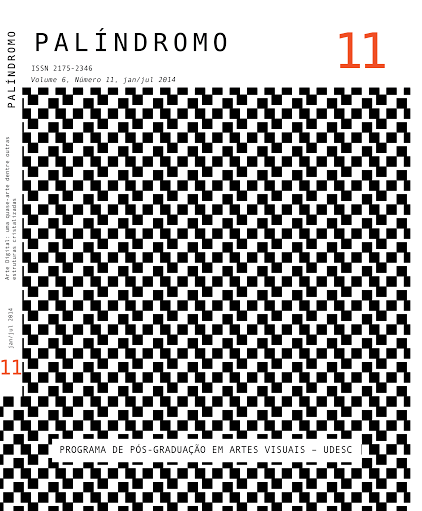Subjectivity and corporality: elements of digital art
DOI:
https://doi.org/10.5965/2175234606112014114Keywords:
subjectivity, technology, body, digital artAbstract
The present work is a reflection on the digital art and the relationship established between the subject and his own body. To understand this relationship, which includes a social and philosophical view, we listed the important features of the history of modern art and its developments up to the digital art. The concept of subjectivity and corporality are incorporated to explain about the poetic proposal in the exhibition We Are The Art which will serve as a case study.
Downloads
References
ARANTES, Priscila. @rte e Mídia - Perspectivas da estética digital. São Paulo, Editora Senac, 2005.
ARGAN, Giulio Carlo. Clássico e Romântico. In: . Arte Moderna. São Paulo, Companhia das Letras, 2004.
CLARK, Lygia, GULLAR, Ferreira, Pedrosa, Mário. Lygia Clark - Arte Brasileira Contemporânea. Rio de Janeiro, FUNARTE, 1980.
DIAS, RMS. Notas introdutórias de uma analítica no campo das modelizações voca- cionais. In JACÓ-VILELA, AM., CEREZZO, AC., and RODRIGUES, HBC., orgs. Clio-psyché: fazeres e dizeres psi na história do Brasil [online]. Rio de Janeiro: Centro Edelstein de Pesquisas Sociais, 2012. p. 262-274. ISBN: 978-85-7982-061-8. Available from SciELO Books < books.scielo.org>.
FRICKE, Christiane. Novos Medioa. WALTHER, Ingo F. (org.). In: ____. Arte do Século XX. Köln, Taschen, 2010.
HARRISON, Charles.Modernismo. São Paulo, Cosac &Naify, 2001.
HAUSER, Arnold. Rococó, Classicismo e Romantismo. In: ____. A História Social da Arte e da Literatura. São Paulo, Martins Fontes, 2003.
LÉVY, PIERRE. Entrevista Pierre Lévy. Revista ComCiência, versão online nº 131. Campinas, 2011. Disponível em http://comciencia.scielo.br/scielo.phpscript=sci_arttext&pid=S1519-76542011000700013&lng=pt&nrm=iso. Acesso em 14 jun 2014.
LIPOVETSKY, Gilles; SERROY, Jean. O mundo como imagem e como comunicação. In: ____. A cultura-mundo. São Paulo, Companhia das Letras, 2008.
MANSANO, Sonia Regina Vagas. Sujeito, subjetividade e modos de subjetivação na contemporaneidade. São Paulo, UNESP, 2009. Disponível em http://www2.assis.unesp.br/revpsico/index.php/revista/article/viewFile/139/172. Acesso em 05 set 2014.
MIDLEJ, Dilson, PORTELA, Antonio Carlos. Texto Curatorial da exposição A Arte Somos Nós. In A Arte Somos Nós: questionamentos sobre o papel do fruidor na hipermodernidade. Cachoieira, 2014. Disponível em http://pt.scribd.com/doc/223079270/A-ARTE-SOMOS-NOS-questoes-sobre-o-papel-do-fruidor-na-hipermodernidade. Acesso em 02 set 2014.
MEDEIROS, Izabella Maria. A Relação entre o corpo e subjetividade na obra de Lygia Clark. Maceió, 2009. Disponível em http://abrapso.org.br/siteprincipal/images/Anais_XVENABRAPSO/185.%20a%20rela%C7%C3o%20entre%20corpo%20e%20 subjetividade%20na%20obra%20de%20lygia%20clark.pdf. Acesso em 13 jun 2014.
MELO, Zimaldo. A Arte Somos Nós: questionamentos sobre o papel do fruidor na hipermodernidade. Cachoieira, 2014. Disponível em http://pt.scribd.com/doc/223079270/A-ARTE-SOMOS-NOS-questoes-sobre-o-papel-do-fruidor-na-hipermodernidade. Acesso em 12 abril 2014.
MERLEAU-PONTY, Maurice. O mundo percebido. In: ____. Fenomologia da Percepção. São Paulo, Martins Fontes, 1999.
MIRANDA, Luciana Lobo. Subjetividade: a (des)construção de um conceito. In: Subjetividade em questão: a infância como crítica da cultura. (Org.: SOUZA, Solange Jobim). Rio de Janeiro, 7Letras, 2005.
SEEGER, Anthony; da MATTA, Roberto; VIVEIROS de CASTRO, E.B. A Construção da Pessoa nas Sociedades Indígenas. Rio de Janeiro, Boletim do Museu Nacional, 1979. Disponível em
TASSINARI, Alberto. O Espaço Moderno. São Paulo, Cosac Naif, 2001.
Downloads
Published
How to Cite
Issue
Section
License
Copyright (c) 2014 Vaneza Rita Silva Melo

This work is licensed under a Creative Commons Attribution 4.0 International License.
COPYRIGHT STATEMENT
The articles published by the magazine are free to use, intended for academic and non-commercial applications. Copyright is all assigned to the magazine. The articles whose authors are identified represent the expression from the point of view of their authors and not the official position of Palíndromo Magazine. The author (s) commits to whenever they publish material referring to the article published in Palíndromo mention this publication as follows:
This article was originally published by Palíndromo magazine in its volume (place the volume), number (place the number) in the year of (place the year) and can be accessed at: http://www.revistas.udesc.br/index.php/palindromo


